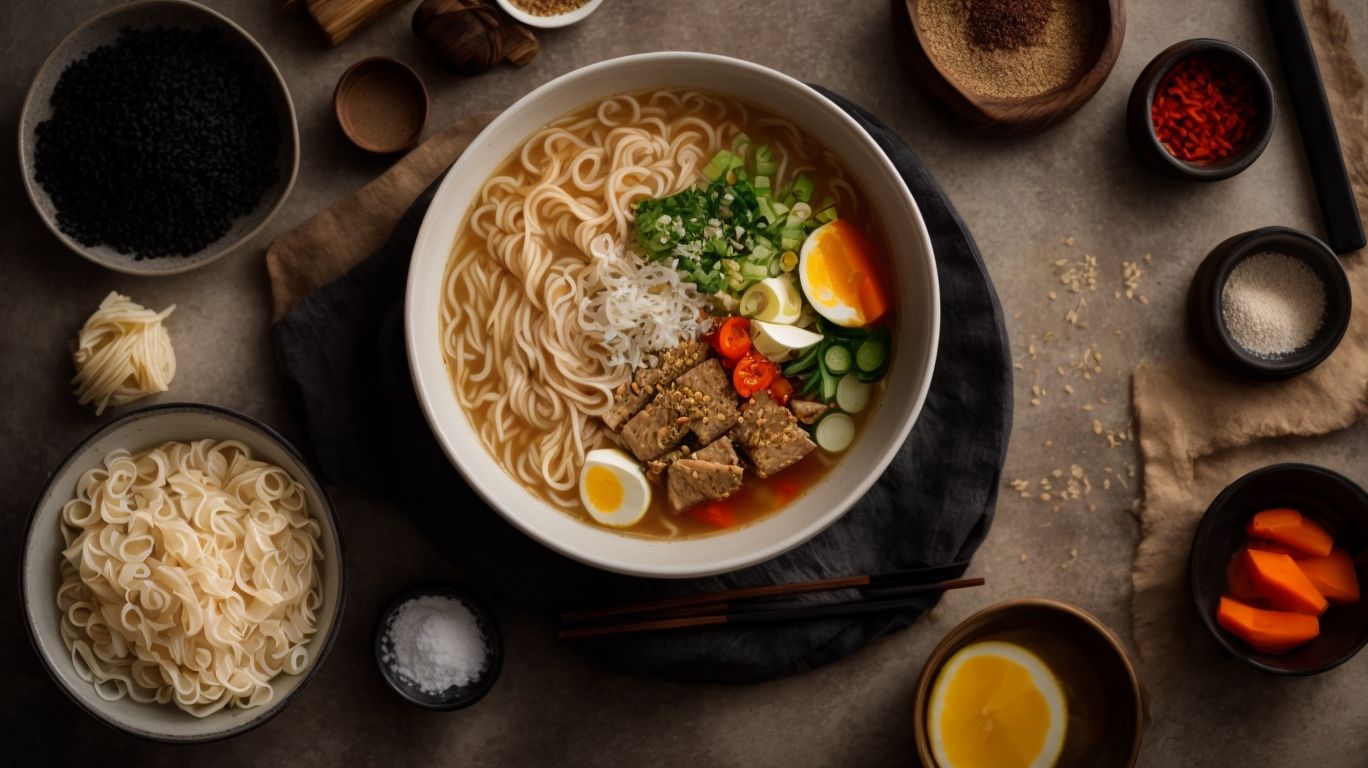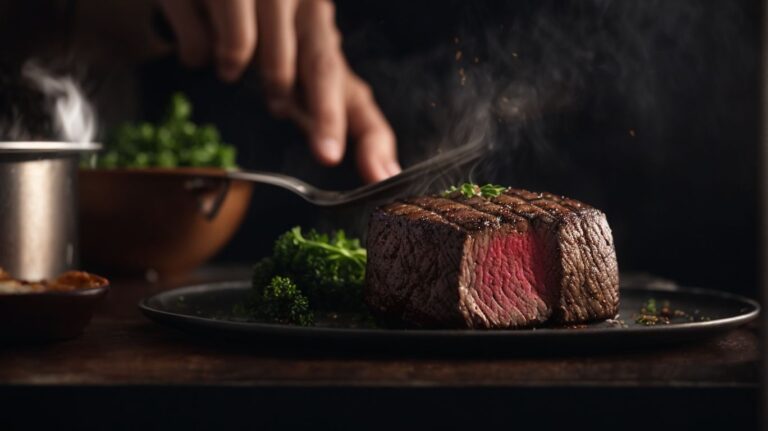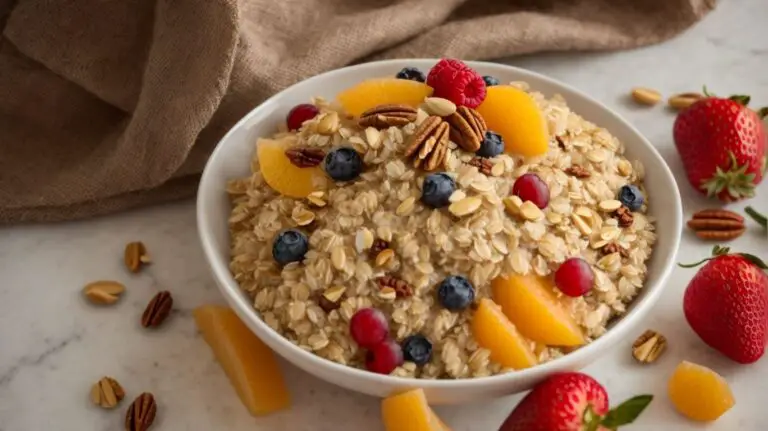How to Cook Noodles for Ramen?
Are you a ramen lover looking to recreate your favorite noodle dish at home?
We will explore the different types of ramen noodles, the essential ingredients needed to cook them, and a step-by-step guide to preparing a delicious bowl of ramen.
From preparing the broth to assembling the perfect bowl, we will cover everything you need to know to achieve that authentic ramen flavor.
Get expert tips on achieving perfectly cooked ramen noodles every time and enjoy your homemade ramen noodles!
Key Takeaways:
What Are the Different Types of Ramen Noodles?
Ramen noodles come in various forms, including fresh ramen noodles, dried ramen noodles, and instant ramen noodles.
Each type of ramen noodle offers a unique experience for those craving a delicious bowl of comfort food.
- Fresh ramen noodles, often found in ramen shops and Asian markets, have a soft and chewy texture that adds a delightful bite to the dish. They require a shorter cooking time due to their fresh state, usually just a quick boil before serving.
- Dried ramen noodles are more commonly found in supermarkets and are convenient for quick meals at home. These noodles have a firmer texture and absorb flavors well from the broth. They need to be cooked in boiling water for a few minutes until al dente.
- Instant ramen noodles, a staple in many college dorm rooms, are pre-cooked and dehydrated for a longer shelf life. They are typically packaged with seasoning powder and can be prepared by pouring hot water over them. While they may lack the texture of fresh or dried noodles, they offer a quick and easy meal option.
Fresh Ramen Noodles
Fresh ramen noodles are made from simple ingredients and are known for their chewy texture and ability to absorb flavors effectively.
When crafting fresh ramen noodles, a key step involves mixing high-protein wheat flour, a small amount of water, and kansui or alkaline mineral water. This unique combination creates a dough that is kneaded until it reaches the perfect elasticity. The dough is then rested to allow gluten proteins to relax, resulting in that distinct chewiness ramen noodles are renowned for. After the resting period, the dough is rolled out and cut into thin strips using precision and care, ensuring consistency in texture and thickness.
Dried Ramen Noodles
Dried ramen noodles are convenient and have a longer shelf life, making them a popular choice for quick and easy meals.
These noodles typically come in a block or nest-like form, ready to be rehydrated in hot water before being added to flavorful broths or stir-fries. The key to preparing ramen just right lies in the noodles‘ texture – ideally springy yet tender. The great thing about dried ramen noodles is their versatility; you can customize them with a variety of toppings like soft-boiled eggs, green onions, nori, or even slices of meat.
Instant Ramen Noodles
Instant ramen noodles are a pantry staple for many, offering a speedy meal option with a variety of flavors to choose from.
Whether you’re a busy student, a late-night snacker, or just someone craving a quick and savory meal, instant ramen noodles have a universal appeal. Their convenience is unmatched – simply pour boiling water, add the flavor packet, and in a matter of minutes, you have a steaming bowl of delicious noodles ready to enjoy. With flavors ranging from classic chicken and beef to unique options like kimchi and shrimp, there’s something to satisfy every palate. It’s no wonder that ramen has become a beloved comfort food around the world!
What Ingredients Do You Need to Cook Ramen Noodles?
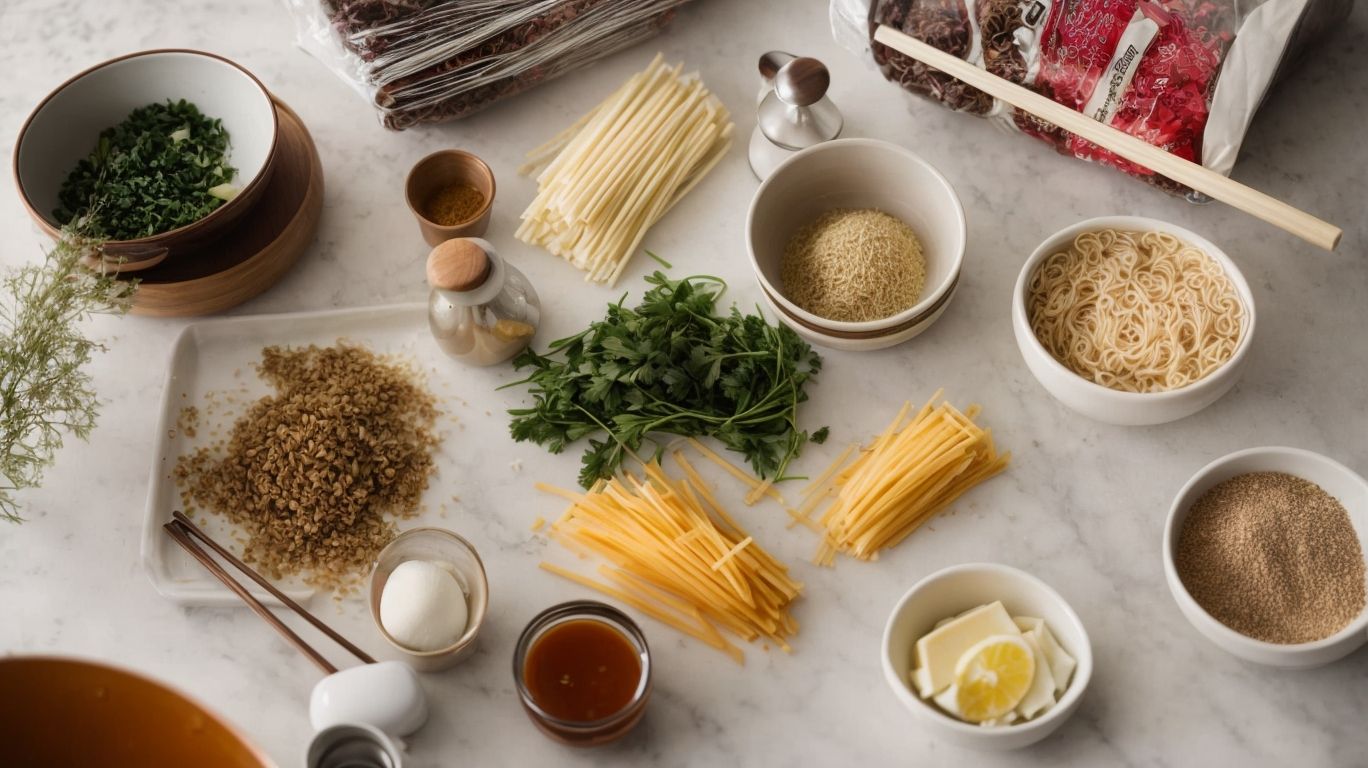
Credits: Poormet.Com – Brandon Anderson
To cook delicious ramen noodles, you’ll need a combination of key ingredients such as broth, noodles, seasonings, vegetables, and protein like eggs or meat.
Broth serves as the base of your ramen, infusing the dish with depth and richness.
Noodles are the heart of the dish, providing that comforting chewy texture.
Seasonings such as soy sauce, miso paste, or sesame oil elevate the flavor profile.
Vegetables add freshness and crunch, while protein sources like eggs or meat offer a substantial element to the meal.
Each ingredient plays a crucial role in creating a well-balanced and flavorful bowl of ramen.
Step-by-Step Guide to Cooking Ramen Noodles
Mastering the art of cooking ramen noodles involves a series of steps, from preparing the broth to assembling the perfect bowl of comfort and flavor.
First, start by selecting your choice of ramen noodles, whether it’s the traditional dried noodles or fresh ones. Boil water in a pot and add the noodles, ensuring they cook to your desired firmness. Meanwhile, prepare the broth by simmering a combination of stock, soy sauce, miso paste, and aromatics like ginger and garlic. Next, cook your preferred toppings such as soft-boiled eggs, sliced scallions, nori, and protein like sliced pork or tofu. Once the noodles are cooked, strain them and divide into serving bowls. Pour the flavorful broth over the noodles, add your desired toppings, and garnish with nori strips and sesame seeds for an authentic touch. Savor the steaming bowl of homemade ramen filled with rich flavors and textures.”
Preparing the Broth
A flavorful broth is the heart of a delicious ramen bowl, typically made with ingredients like homemade broth, ginger, garlic, and green vegetables.
Creating a rich and aromatic broth for ramen noodles involves layering flavors with care and precision. One popular method is to start by simmering pork bones, chicken, or a combination of both for several hours to extract all the savory goodness. To enhance the depth of the broth, key ingredients like kombu, dried shiitake mushrooms, and soy sauce are added for that umami punch. A touch of sesame oil towards the end infuses nuttiness into the broth, elevating the overall taste profile.
Preparing the Noodles
Cooking the noodles to the perfect texture is crucial for an authentic ramen experience, whether using fresh, dried, or instant varieties.
For fresh ramen noodles, it’s best to cook them for a shorter period to maintain their chewy texture. Boil them for about 2-3 minutes before adding them to the hot broth.
On the other hand, dried ramen noodles require a slightly longer cooking time. They usually need to be boiled for 4-5 minutes until they reach an al dente consistency.
Instant ramen noodles, popular for their convenience, are typically precooked and just need to be rehydrated in boiling water for a few minutes before adding the flavoring packets.
Cooking the Noodles
Achieving the right level of doneness for the noodles requires precise timing and proper boiling water, ensuring they are cooked to perfection.
To cook ramen noodles in boiling water, bring a pot of water to a rolling boil before adding the noodles. Stir the noodles gently to prevent sticking and ensure even cooking. Keep a close eye on the timer, as overcooked noodles can become mushy. Remember, noodles will continue to cook slightly even after removing from heat, so factor in the residual heat. For optimal results, use a timer and refer to the package instructions for the recommended cooking time. Strain the noodles promptly once they reach the desired texture, and immediately rinse them with cold water to stop the cooking process.
Assembling the Ramen Bowl
The final step in creating a delightful ramen dish involves assembling the cooked noodles, broth, and an array of toppings such as scallions, sesame seeds, and sliced cheddar.
Regarding topping your ramen bowl, the possibilities are as vast as your imagination. From soft-boiled eggs to crispy nori strips, each element adds its own unique flavor and texture to the dish. Don’t forget the fresh vegetables like bok choy and bean sprouts for a burst of color and crunch.
Remember, the key to an eye-catching ramen presentation is in the arrangement of these toppings. Whether you opt for a traditional layout or get creative with a modern twist, make sure each ingredient shines on its own while complementing the overall aesthetic of the dish.
Tips for Perfectly Cooked Ramen Noodles
Ensuring your ramen noodles turn out perfectly requires attention to detail and following some essential tips to enhance their flavor and texture.
Start by choosing the right type of noodles for your ramen. Opt for fresh noodles for a more authentic taste or dried noodles for convenience.
When cooking the noodles, follow the instructions on the packaging carefully to achieve the ideal texture – typically a slightly chewy consistency.
Experiment with different cooking techniques like boiling, steaming, or stir-frying the noodles to find your preferred method.
Enhance the flavor of your ramen by using high-quality broth, adding fresh ingredients like veggies, protein, and noodles, and incorporating flavorful seasonings like soy sauce, miso, or chili oil.
Don’t forget to garnish your bowl with toppings such as sliced green onions, soft-boiled eggs, nori, or sesame seeds for that extra burst of flavor.
Use the Right Type of Noodles
Selecting the appropriate type of noodles for your ramen dish can significantly impact the overall taste and texture of the final creation.
Regarding choosing the perfect noodles for your ramen, you must consider various factors. The thickness of the noodles can determine how well they absorb the flavors of the broth. Thicker noodles are great for hearty broths, while thinner ones work well with lighter, more delicate flavors. The texture of the noodles plays a crucial role. Are you looking for chewy, springy noodles, or perhaps you prefer a softer, more slippery texture? Different noodle types offer a range of textures to suit your preferences.
Cook the Noodles in Boiling Water
Boiling the noodles in adequately heated water ensures they cook evenly and maintain their desired firmness without becoming mushy.
When cooking ramen noodles, using boiling water is crucial to prevent them from clumping together and sticking, resulting in a more appetizing presentation. The high temperature of the water also helps to break down the starches in the noodles, making them easier to digest and enhancing their texture. It’s recommended to bring the water to a rolling boil before adding the noodles, ensuring quick and even cooking. Remember to follow the recommended cooking times on the package to achieve the perfect consistency – usually around 2-3 minutes. Overcooking can lead to soggy noodles, while undercooking may leave them too hard.
Rinse the Noodles After Cooking
Rinsing cooked noodles under cold water helps remove excess starch and prevents them from sticking together, ensuring a more pleasant eating experience.
Rinsing the cooked noodles not only enhances their texture but also contributes to the overall flavor profile of your ramen dish. By rinsing off the residual starch, you can achieve a perfect balance in the consistency of the noodles, allowing them to absorb the savory broth or sauces more efficiently.
This simple yet crucial step plays a crucial role in elevating the quality of your ramen bowl, resulting in a more authentic and satisfying culinary experience.
Use High-Quality Broth
The quality of your broth can elevate the entire ramen dish, so investing time in preparing a flavorful and rich broth is key to a satisfying meal.
Regarding crafting the perfect ramen experience, the broth serves as the heart and soul of the dish. A well-made broth can take your humble bowl of noodles to new culinary heights. Whether you opt for a classic tonkotsu broth simmered with pork bones for hours on end or a light and delicate shoyu broth, the choice of ingredients and the cooking technique significantly impact the final flavor profile.
For a more robust and deeply flavored ramen, consider using a blend of chicken and pork bones in your broth. The combination of meats creates a multi-dimensional richness that coats each strand of noodle deliciously.
Add Toppings for Extra Flavor
Customizing your ramen bowl with a variety of toppings such as sliced cheddar, scallions, sesame seeds, or sautéed mushrooms can add layers of flavor and texture.
For a burst of freshness, consider adding crispy bamboo shoots and pickled ginger to your ramen for a delightful contrast of flavors. Topping your noodles with a perfectly soft-boiled egg can introduce a rich velvety element, while a sprinkle of crushed nori seaweed can infuse a hint of umami. To elevate your ramen game further, try incorporating spicy kimchi or crispy fried shallots on top. The possibilities are endless when it comes to customizing your bowl with a vast array of top-notch ingredients.
Conclusion: Enjoy Your Homemade Ramen Noodles!
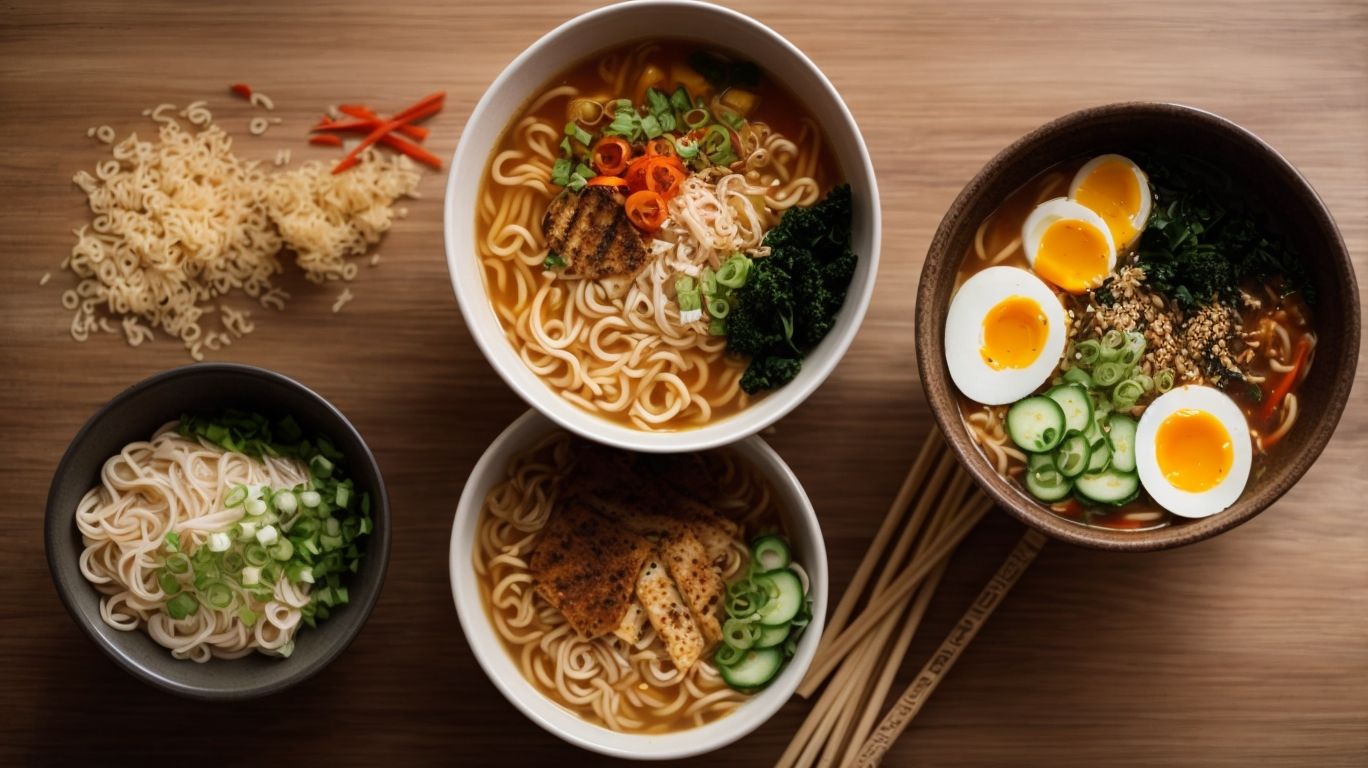
Credits: Poormet.Com – Gregory Nelson
Savor the delightful experience of relishing your homemade ramen noodles, crafted with care and creativity to suit your taste preferences.
There is something truly special about immersing yourself in the process of creating a bowl of comfort and flavor from scratch. The versatility that comes with making your own noodles allows you to experiment with different textures and flavors, ensuring that every bite is uniquely satisfying. Whether you prefer a rich, umami broth or a lighter, more delicate soup base, the beauty of homemade ramen lies in its ability to adapt to your personal cravings.
Don’t forget the joy of choosing your favorite toppings and garnishes – from a perfectly soft-boiled egg to crispy strips of seaweed or a generous sprinkle of freshly chopped green onions. These little additions can elevate your homemade ramen to restaurant-quality status, all while bringing a touch of warmth and comfort to every slurp.
So, why not treat yourself to a cozy night in and embark on a culinary adventure with your very own custom-made bowl of ramen noodles? With each ingredient selected by you and every step of preparation infused with your personal flair, the end result is bound to be a delicious revelation that captures the essence of homemade comfort food at its finest.
Frequently Asked Questions
What type of noodles should I use for ramen?
You should use fresh ramen noodles for the most authentic and flavorful ramen dish. However, if fresh noodles are unavailable, you can also use dried ramen noodles or even spaghetti noodles as a substitute.
Do I need to boil the noodles before adding them to the broth?
Yes, it is important to cook the noodles separately before adding them to the broth. This prevents the noodles from becoming too soft and mushy and also allows you to control the texture of the noodles.
How long should I cook the noodles for?
The cooking time for noodles varies depending on the type of noodles you are using. Fresh ramen noodles only need to be cooked for 2-3 minutes, while dried noodles may need to be cooked for 4-5 minutes. It’s best to follow the instructions on the package for the most accurate cooking time.
Can I use the same pot of water to cook the noodles and make the broth?
No, it is not recommended to use the same pot of water for cooking the noodles and making the broth. The starchy water from the noodles can affect the flavor and clarity of the broth.
Do I need to rinse the noodles after cooking?
If you are using fresh noodles, there is no need to rinse them after cooking. However, if you are using dried noodles, it is recommended to rinse them with cold water to remove any excess starch and prevent them from sticking together.
Can I make the noodles ahead of time and reheat them later?
Yes, you can cook the noodles ahead of time and store them in the refrigerator for 1-2 days. When ready to use, simply reheat them in boiling water for a few minutes before adding them to the broth. Be sure to rinse the noodles with cold water after reheating to prevent them from overcooking.

